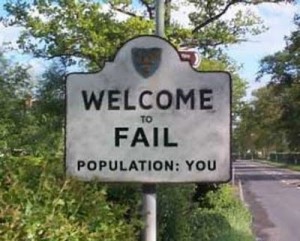Risk and Failure part 3 – The Failure Revolution
In part 1, I talked about why failure was critical to success.
In part 2, I talked about how you can make yourself take more risks and be more failure tolerant.
But it’s almost impossible to take risks and fail in an environment that doesn’t support it, especially in the workplace.
Most businesses don’t support risk taking and failure. They WANT people to take risks -that’s how innovation happens. And in today’s environment, companies either constantly innovate or get eaten. But most companies are structured to actively prevent risk.
A team or company that supports risk and small failures has to be like an improv troupe
(you didn’t think I was going to write this WITHOUT mentioning improv, did you?
The Failure Revolution
Remember “yes, and”? Improv troupes encourage risk taking because anything said by a player is treated as though it was perfect. All the other players agree to what was said, and add to it – “yes, and”.
How would this work in business, and how would it encourage risk taking and failure tolerance:
You’re in a meeting talking about how to update your hottest product, a toaster, and Harold chimes in with “we should make it fly”.
If you can come up with a stupider idea, let me know – I’d love hear it.
The usual take on that would be for everyone to look at Harold, and either shoot the idea down directly or indirectly by saying something like “interesting – we’ll table that and talk about it offline sometime”.
You think Harold will ever share an idea again? Not likely. Nor will anyone else in that meeting that saw Harold shredded for his stupid comment. After that most people will shoot down their own ideas before ever mentioning them just to save themselves from public embarrassment. They say to themselves that they’ll only share the GOOD ideas, but no idea will be so good its ridicule-proof.
Add “yes, and…”
Harold suggests making the toasters fly. Someone in the meeting says “yes, and we should add little jets to it to go fast”. Someone else says “yes, and we could reshape it like a one those Blue Angel airplanes”. Another says “yes, and paint it blue with those yellow pinstripes”.
The ideas aren’t any better than Harold’s, but they’re building momentum, inspiring creativity, and leading to some usable ideas – a sleeker form factor, custom color schemes, etc. Every one of the ideas above is a risk to say (they’re silly and impractical), and a failure – there’s no market (yet) for a flying toaster. But building off them as a team creates an environment where it’s safe and enjoyable to take risks and fail.
Making Failure Safe
Let’s go one step further…
Harold takes a small risk. He has the art department draw up a very quick sketch of the flying toaster complete with min-jet engines, airfoils, wings, and tail fins. Yes, and-ing really isn’t in the cards – the idea has gone as far as it can before you have to start spending money on it. The leader of an efficient, creative, risk-taking team will have fun with it and reward Harold for that risk. “Wow, that is the scariest toaster I’ve ever seen! Very impressive Harold! I think this gets the golden-toasty award for the toaster design most likely to be used by the military!”
Have fun with it. Give an award for the worst idea of the week. Laugh about it, and laugh at your own rotten ideas (“It still can’t top my submersible toaster – that was a REAL disaster!”).
Add “yes, and” to work a bad idea into a good idea, and support the risk taker. Have fun with the team and make failing acceptable and enjoyable. At the end of a good movie, everyone loves sticking around and watching out-takes – the on-camera failures – that happened along the way. When failure leads to success, risks become less risky, and failure is just a fast way to get results.

